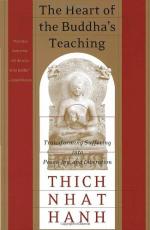
|
| Name: _________________________ | Period: ___________________ |
This test consists of 15 multiple choice questions and 5 short answer questions.
Multiple Choice Questions
1. Siddhartha Gutama sat under a bodhi tree and vowed not to get up until when?
(a) Nightfall.
(b) He understood how to alleviate suffering.
(c) He was tired of sitting.
(d) Someone had come to save him.
2. If we destroy living beings or the environment with what we eat, we are eating what?
(a) Life.
(b) Ourselves.
(c) Trash.
(d) The flesh of our children.
3. We must practice what to understand the Four Noble Truths?
(a) The twelve turnings of the wheel of Dharma.
(b) Quiet.
(c) Patience.
(d) Mindfulness.
4. What does the wheel of Dharma teach?
(a) The Right Way.
(b) Your Way.
(c) The Middle Way.
(d) Buddha's Way.
5. The practice of the Five Mindfulness Trainings addresses what?
(a) The "goods" we ingest.
(b) The "good" we ingest.
(c) The "bad" we ingest.
(d) The nutriments.
6. The third Mindfulness training is about what?
(a) Sexual responsibility.
(b) Parental responsibilty.
(c) Ingesting healthy foods.
(d) Community responsibility.
7. The first four miracles of mindfulness belong to the first aspect of meditation known as __________.
(a) Shamhara.
(b) Sithartha.
(c) Samantha.
(d) Shamatha.
8. What is the Seventh Miracle of Mindfulness?
(a) Believing.
(b) Forgiving.
(c) Transformation of our suffering as well as the suffering of the world.
(d) Understanding.
9. The Discourse on the Four Establishments of Mindfulness notes how many objects for mindfulness practice?
(a) Six.
(b) Four.
(c) Seven.
(d) Five.
10. Speaking each person's individual language, like Bodhisattva, or writing a letter using Right speech, can do what?
(a) Benefit no one.
(b) Benefit sender and receiver.
(c) Benefit the receiver.
(d) Benefit the sender.
11. What is the Sixth Miracle of Mindfulness?
(a) Forgiving.
(b) Understanding.
(c) Believing.
(d) Transformation of our suffering as well as the suffering of the world.
12. Looking deeply in meditation is important, but what else is fundamental?
(a) Enjoying life.
(b) Stopping to do so.
(c) Relaxing.
(d) Not thinking.
13. Suffering, its recognition, making, and the path out of it are all ___________, as are the Four Noble Truths.
(a) Separate.
(b) Unique.
(c) Intertwined.
(d) Alone.
14. Right Speech is speaking how?
(a) Truthfully, no matter how painful it may be.
(b) Compassionately, in a way not to hurt others.
(c) Truthfully, not with a forked tongue, not cruelly or slanderously and not exaggeration.
(d) Quietly and infrequently.
15. Buddha taught the Eightfold Path until when?
(a) He changed his teaching methods.
(b) His death.
(c) He became ill.
(d) He was sixty.
Short Answer Questions
1. "To practice social justice and non-exploitation, we have to use __________________."
2. Hanh suggests reframing the four Noble Truths, replacing "cessation" with what?
3. What does Hanh suggest doing to our habit energies?
4. Right thinking is known as what?
5. How many months of mindfulness and enjoying the present moment brings real happiness, according to Hahn?
|
This section contains 454 words (approx. 2 pages at 300 words per page) |

|




